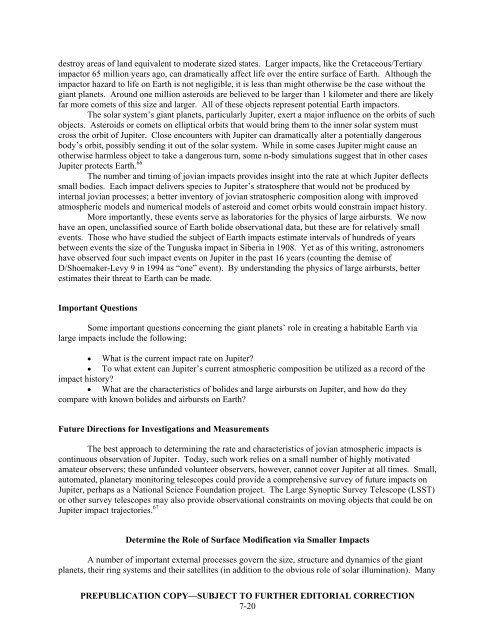Vision and Voyages for Planetary Science in the - Solar System ...
Vision and Voyages for Planetary Science in the - Solar System ...
Vision and Voyages for Planetary Science in the - Solar System ...
Create successful ePaper yourself
Turn your PDF publications into a flip-book with our unique Google optimized e-Paper software.
destroy areas of l<strong>and</strong> equivalent to moderate sized states. Larger impacts, like <strong>the</strong> Cretaceous/Tertiary<br />
impactor 65 million years ago, can dramatically affect life over <strong>the</strong> entire surface of Earth. Although <strong>the</strong><br />
impactor hazard to life on Earth is not negligible, it is less than might o<strong>the</strong>rwise be <strong>the</strong> case without <strong>the</strong><br />
giant planets. Around one million asteroids are believed to be larger than 1 kilometer <strong>and</strong> <strong>the</strong>re are likely<br />
far more comets of this size <strong>and</strong> larger. All of <strong>the</strong>se objects represent potential Earth impactors.<br />
The solar system’s giant planets, particularly Jupiter, exert a major <strong>in</strong>fluence on <strong>the</strong> orbits of such<br />
objects. Asteroids or comets on elliptical orbits that would br<strong>in</strong>g <strong>the</strong>m to <strong>the</strong> <strong>in</strong>ner solar system must<br />
cross <strong>the</strong> orbit of Jupiter. Close encounters with Jupiter can dramatically alter a potentially dangerous<br />
body’s orbit, possibly send<strong>in</strong>g it out of <strong>the</strong> solar system. While <strong>in</strong> some cases Jupiter might cause an<br />
o<strong>the</strong>rwise harmless object to take a dangerous turn, some n-body simulations suggest that <strong>in</strong> o<strong>the</strong>r cases<br />
Jupiter protects Earth. 66<br />
The number <strong>and</strong> tim<strong>in</strong>g of jovian impacts provides <strong>in</strong>sight <strong>in</strong>to <strong>the</strong> rate at which Jupiter deflects<br />
small bodies. Each impact delivers species to Jupiter’s stratosphere that would not be produced by<br />
<strong>in</strong>ternal jovian processes; a better <strong>in</strong>ventory of jovian stratospheric composition along with improved<br />
atmospheric models <strong>and</strong> numerical models of asteroid <strong>and</strong> comet orbits would constra<strong>in</strong> impact history.<br />
More importantly, <strong>the</strong>se events serve as laboratories <strong>for</strong> <strong>the</strong> physics of large airbursts. We now<br />
have an open, unclassified source of Earth bolide observational data, but <strong>the</strong>se are <strong>for</strong> relatively small<br />
events. Those who have studied <strong>the</strong> subject of Earth impacts estimate <strong>in</strong>tervals of hundreds of years<br />
between events <strong>the</strong> size of <strong>the</strong> Tunguska impact <strong>in</strong> Siberia <strong>in</strong> 1908. Yet as of this writ<strong>in</strong>g, astronomers<br />
have observed four such impact events on Jupiter <strong>in</strong> <strong>the</strong> past 16 years (count<strong>in</strong>g <strong>the</strong> demise of<br />
D/Shoemaker-Levy 9 <strong>in</strong> 1994 as “one” event). By underst<strong>and</strong><strong>in</strong>g <strong>the</strong> physics of large airbursts, better<br />
estimates <strong>the</strong>ir threat to Earth can be made.<br />
Important Questions<br />
Some important questions concern<strong>in</strong>g <strong>the</strong> giant planets’ role <strong>in</strong> creat<strong>in</strong>g a habitable Earth via<br />
large impacts <strong>in</strong>clude <strong>the</strong> follow<strong>in</strong>g:<br />
• What is <strong>the</strong> current impact rate on Jupiter?<br />
• To what extent can Jupiter’s current atmospheric composition be utilized as a record of <strong>the</strong><br />
impact history?<br />
• What are <strong>the</strong> characteristics of bolides <strong>and</strong> large airbursts on Jupiter, <strong>and</strong> how do <strong>the</strong>y<br />
compare with known bolides <strong>and</strong> airbursts on Earth?<br />
Future Directions <strong>for</strong> Investigations <strong>and</strong> Measurements<br />
The best approach to determ<strong>in</strong><strong>in</strong>g <strong>the</strong> rate <strong>and</strong> characteristics of jovian atmospheric impacts is<br />
cont<strong>in</strong>uous observation of Jupiter. Today, such work relies on a small number of highly motivated<br />
amateur observers; <strong>the</strong>se unfunded volunteer observers, however, cannot cover Jupiter at all times. Small,<br />
automated, planetary monitor<strong>in</strong>g telescopes could provide a comprehensive survey of future impacts on<br />
Jupiter, perhaps as a National <strong>Science</strong> Foundation project. The Large Synoptic Survey Telescope (LSST)<br />
or o<strong>the</strong>r survey telescopes may also provide observational constra<strong>in</strong>ts on mov<strong>in</strong>g objects that could be on<br />
Jupiter impact trajectories. 67<br />
Determ<strong>in</strong>e <strong>the</strong> Role of Surface Modification via Smaller Impacts<br />
A number of important external processes govern <strong>the</strong> size, structure <strong>and</strong> dynamics of <strong>the</strong> giant<br />
planets, <strong>the</strong>ir r<strong>in</strong>g systems <strong>and</strong> <strong>the</strong>ir satellites (<strong>in</strong> addition to <strong>the</strong> obvious role of solar illum<strong>in</strong>ation). Many<br />
PREPUBLICATION COPY—SUBJECT TO FURTHER EDITORIAL CORRECTION<br />
7-20











